PODCAST 194 DROPPED! Pre-emergence Herbicides for Perennial Growers
The latest Tech On Demand podcast covers an important topic for greenhouse and nursery growers producing perennials. For episode 194, I was joined by frequent guest and Corteva’s technical guru, flower grower and greenhouse and nursery “coach” Broch Martindale. He was back on the podcast to share strategies for controlling weeds in perennial production using pre-emergence products like Gallery, Dimension and Snapshot.
What was really cool was that we recorded this episode live in The Gardens at Ball on the Wednesday before Ball Seed Customer Days at the end of July. It was a blazing hot day, and we were sweating, but you won’t notice that in the podcast—hopefully.

Over the course of this episode, we discussed selecting the best products to control specific weeds impacting crops each season. We talked about why it’s important to apply pre-emergence products in the fall to provide control through winter and into spring because weeds can take over when temps drop.
I asked Broch for some general “best practices” to not only keep weeds at bay, but also reduce costs associated with labor and product purchase. Of course, he delivered! Broch has helped countless greenhouses and nurseries improve their processes, so his approach is 100% real-world. You’re going to really enjoy this episode.
Listen on all the major podcast apps. Links to Spotify and Apple Podcasts are below. And make sure you subscribe so you never miss an episode. If you can, leave a positive review to help us reach more greenhouse professionals. Lastly, jump back into the archives, because we have 193 more episodes (as of today) covering a huge range of topics.

Nick’s Tip of the Week: Precipitous Problems for Primula
Each week, I’ll work with my buddy Nick Flax, a technical services expert at Ball, to share a concern that’s come up during one of his numerous calls with growers across North America. This week, he’s discussing a fall crop that doesn’t usually get much press: Primula.
PROBLEM: In addition to typical fall color crops like mums and Celosia, many growers have Primula on their benches right now, as well. This week, I got a question about a physiological disorder that I see in this crop every year—calcium (Ca) deficiency.
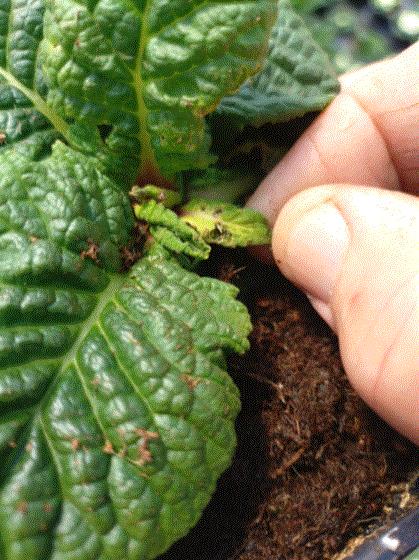
NICK’S TIP: If you have Primula growing in your greenhouse right now, take note and be on the lookout for symptoms in the coming weeks!
Calcium Deficiency Symptoms
Often mistaken for foliar disease pressure, calcium deficiency (a.k.a.“tip burn”) can cause major damage to a Primula crop if left unchecked:
-
Early symptoms on new, developing leaves include chlorosis and tight curling of the margins.
-
On maturing leaves, early symptoms often look like mild chlorosis akin to mineral nutrient deficiency.
-
As symptoms advance, tips and edges of leaves become brown and necrotic. Heavily-symptomatic leaves continue to decline, and secondary pathogens like Botrytis often infect the compromised tissue.
-
Affected tissues cannot recover from damage and will remain stunted and distorted for the life of the plant. However, if the deficiency is corrected, new growth can cover up the damaged leaves and preserve the overall aesthetic of the crop.
What Causes Ca Deficiency?
Fundamentally, Ca moves via bulk flow of water through plants. This means that Ca travels into the roots with the uptake of water and is “pulled” through plants as they transpire (release water vapor through the stomata in leaves). For starters, ensure that your fertilizer program provides sufficient Ca to plants:
-
Fertilizers like 20-10-20 are used by many growers to produce Primula, but most of these formulations do not supply any Ca. If 20-10-20 or similar formulations lacking Ca are mainstays in your crop production strategy because of water quality concerns like high alkalinity (check out my past tech tip on this HERE), be sure to provide Ca via other means.
-
An easy way to supplement Ca through traditional fertilizer applications is to alternate with a more nitrate-based fertilizer like a CalMag (ex. 15-5-15 or 17-5-17) or 15-0-15. Calcium nitrate is often the primary source of nitrogen in these formulations, so they provide ample Ca to your crops when applied regularly.
While failure to supply enough Ca can occur, environmental and crop-cultural factors that limit uptake and/or movement of water (and the Ca that moves with it) are most often what cause tip burn to occur:
-
The dense rosette of broad leaves that Primula are known for sets them up for challenges with Ca uptake and movement as plants mature. A crowded canopy causes humidity to stay very high immediately around the leaves (this area is called the “boundary layer”). High humidity in the boundary layer, particularly in the very center of a maturing Primula, slows transpiration and movement of Ca to the growing point.
-
High overall relative humidity in the greenhouse, insufficient air movement, and overly crowded plant spacing are common environmental factors in the greenhouse that reduce the flow of Ca to developing tissues.
-
Sudden shifts in the weather from sunny to cloudy or major dips/spikes in air temperature can also disrupt movement of Ca and contribute to deficiency incidences.
-
Frequent, overhead irrigations, waterlogged growing media and long drying times after irrigation/fertigation are other major factors that can drive Ca deficiency in Primula.
How to Avoid or Correct Ca Deficiency
The easiest factor to control is whether enough Ca is being supplied to the crop. Pick the right fertilizer(s) based on your water quality and then focus your efforts on optimization of the growing environment to promote uptake and movement of Ca in the crop:
-
Primula prefer moderate soil moisture levels, but do not grow well with waterlogged media. On the 1 to 5 moisture scale (1=air dry; 5=saturated), water plants up to a level 4 and try to avoid dry-down below a level 2. This will help to promote good flow of water and Ca through plants.
-
Irrigate/fertigate early in the day and avoid late afternoon or evening waterings at all costs. This will ensure the canopy dries quickly and keep Ca moving through plants throughout the day.
-
Ensure that plants are spaced appropriately. If plants are pot-tight after transplant, increase spacing as soon as leaves start to touch adjacent plants.
-
Keep air movement in the greenhouse high with HAF fans, and run dehumidification cycles in the greenhouse before sundown. This is particularly important when night temperatures begin to drop off sharply in fall and the greenhouse hits the dewpoint quickly in the late afternoon/evening.
-
If weather extremes make it difficult to keep Ca moving through the plant via optimization of the greenhouse environment, weekly CaCl (calcium chloride) sprays between 200 and 400 ppm Ca can help to alleviate tip burn. Be sure to add a wetting agent to the spray solution to enhance absorption.

Broad Mites—Identification, Prevention and Control
I’ll link a handful of broad mite resources below (most of them have been shared in past issues of this newsletter), but when looking for more good info, I came across this awesome overview from our friend JC Chong’s PestTalks e-newsletter a few years ago. It’s a concise look at this specific pest, and what’s interesting (to me, anyway) is that he wrote it for his August 26 newsletter (the same week as now), which means this issue comes up frequently at the same time each year. We’ve had reports of broad mite lately, which is why I’m including them this week.
Here’s what JC had to say:
Broad mite loves to infest new growth. Tissues damaged by broad mites don’t expand properly, so the leaves and flowers are distorted, twisted and crinkled. This symptom can often be confused with herbicide damage or poor genetics.
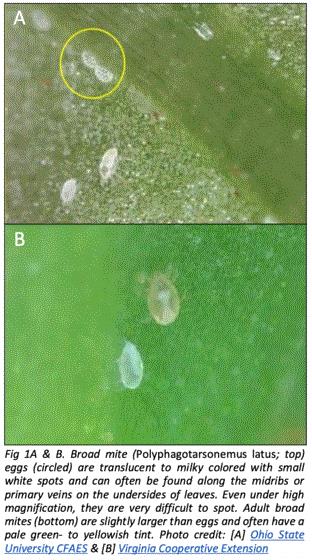 But, if it is broad mite, you’ll be able to find the mites or signs of them being there. The mites and their eggs are translucent, but you can still see them with a hand lens at 16- or 20-times magnification. I ain’t crazy enough to expect y’all to see the long hair sticking out from each mite’s hind legs; I can only see the hairs under a microscope. But I think you can definitely see the eggs, which have several raised white tufts on the surface (look like spots to me), under a hand lens. Its elliptical shape and the white spots give the eggs the look of a football. The eggs stay on the plant surface even if the mites are gone. If you see the eggs, you can almost certainly diagnose this distortion as one caused by broad mite.
But, if it is broad mite, you’ll be able to find the mites or signs of them being there. The mites and their eggs are translucent, but you can still see them with a hand lens at 16- or 20-times magnification. I ain’t crazy enough to expect y’all to see the long hair sticking out from each mite’s hind legs; I can only see the hairs under a microscope. But I think you can definitely see the eggs, which have several raised white tufts on the surface (look like spots to me), under a hand lens. Its elliptical shape and the white spots give the eggs the look of a football. The eggs stay on the plant surface even if the mites are gone. If you see the eggs, you can almost certainly diagnose this distortion as one caused by broad mite.
Click HERE for a fun article by Nicole Casuso and Hugh Smith of University of Florida, with lots of pictures of broad mite life stages.
Broad mites can complete one generation in a couple of weeks, and each female can lay 30 to 70 eggs. They have really interesting behaviors, especially when dispersing to new plants. Many of you probably heard of broad mites latching to the legs of adult whiteflies and then dispersing to new plants when the whiteflies land. (LINK to this article for a great picture!) This behavior, called phoresis, is interesting but, in my mind, no way near as interesting as what a male broad mite would do to ensure his reproductive success. Similar to spider mites, a broad mite goes through a quiescent stage before molting into an adult. A male broad mite will pick up one of these quiescent females, put the female on its back, and carry her everywhere he goes. Why? So that he can make sure that as soon as the female comes of age (i.e. molts into an adult), he can mate with her. Now, don’t be anthropocentric and go “eww.” For a tiny broad mite in a land of giant plants, a male has to do what he can to pass on his genes.
Several predatory mite species, such as Amblyseius andersoni, Amblyseius swirskii, Neoseiulus californicus, Neoseiulus cucumeris and Neoseiulus fallacis, are available for biological control of broad mite. Several studies reported good efficacy with these predatory mites. The keys to success are to release the predatory mites preventively or as soon as damage is observed and keep up with the program with regular releases.
Several miticides are registered for controlling tarsonemid mites (which include broad mite and its close cousin, cyclamen mite)—several pyrethoids (IRAC Group 3A), abamectin (Avid, Minx, Sirocco, etc.; 6), chlorfenapyr (Pylon; 13), fenpyroximate (Akari; 21A), pyridaben (Sanmite; 21A), spiromesifen (Savate/Forbid; 23) and spirotetramat (Kontos; 23). I have worked with broad mite on and off in the past few years, and found two applications of Akari, Avid, Pylon and Savate, 14 days apart, to work quite well.
In addition to the above products, data from IR-4 also suggest good efficacy from horticultural oil, insecticidal soap, emamectin benzoate (Enfold; 6), etoxazole (Beethoven; 10B), fenazaquin (Magus; 21A), hexythiazox (Hexygon; 10A), and milbemectin (Ultiflora; 6). Note that not all of these products are registered for broad mite or cyclamen mite, and some of them are no longer available (such as Ultiflora). Since the mites are hiding in the distorted terminals or crinkled leaves, adding a surfactant to the spray solution, and applying thoroughly and at a high volume, can help improve efficacy. Also, here I go again: rotate, rotate, rotate.

More Broad Mite Resources
Here’s the laundry list of info I found that might help you battle broad mites. Obviously, this list is not exhaustive and there have been many other articles written about the pest.
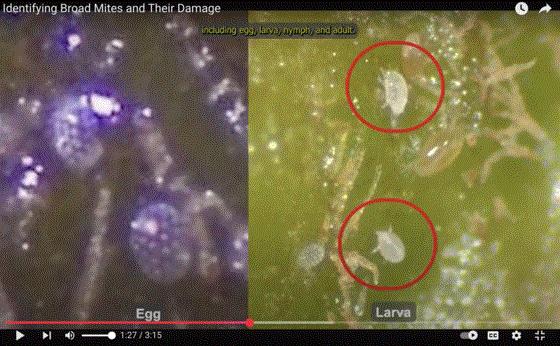
Confirmed presence in greenhouse production seem to be on the rise. I actually discussed this with Dr. Raymond Cloyd in the podcast linked below. Another reason these pests can really be a pain is that they’re miniscule and impossible to see without magnification, and the damage they cause can be easily misidentified. A double whammy.
Poinsettia Disease Detected
I’ve heard some murmurs over the past week or so about a couple odd diseases showing up on poinsettias early in production. One of these is bacterial canker. At least two labs have isolated it, and looking back through our Greenhouse Tech Team Facebook Group, it looks like someone posted photos on August 13 that look suspicious.
Bacterial canker can be quite difficult to spot until it gets really bad later in the season, so keep a close eye on your crops. Thankfully, the Green Solutions Team at Envu just put out a “Fast Facts” sheet on the disease—with details for monitoring and managing bacterial canker.
Here’s the fact sheet—verbatim. Shout out to the Envu team for making this available so quickly!
Bacterial canker, caused by Curtobacterium flaccumfaciens pv. poinsettiae, is a Gram-positive bacterium. This makes it very different from the Gram-negative Xanthomonas (angular leaf spot) and Pectobacterium or Dickeya (cutting and soft rots). Gram-positive bacteria have a thick cell wall made primarily of peptidoglycan reinforced with organic acids, forming a tough protective mesh. This structure resists many antibiotics and detergents, making the bacteria harder to kill than many Gram-negative bacteria.
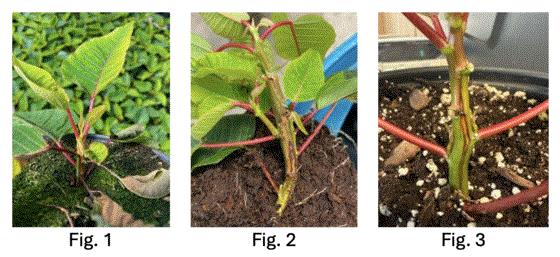
Photos: Envu
Bacterial canker is a systemic disease (a bacterial wilt) that blights poinsettia leaves, bracts and stems. It poses a serious risk in greenhouse production because infections can remain latent for weeks. Symptomless infections have been detected in cuttings early in the season, with visible disease often developing only late in production. Compared to other bacterial diseases, bacterial canker progresses slowly and then seemingly "blows up."
Monitoring
-
Scout for symptoms throughout production. Look for elongated, water-soaked streaks or brown cankers that girdle stems (Fig.1).
-
Defoliation with irregular brown necrotic spots may indicate infection.
-
Wet-looking stem lesions should be sent to a lab for confirmation (Fig. 2).
-
Severe cases may show longitudinal stem cracks and bacterial ooze (Fig. 3).
Management
-
The most effective action during an outbreak is to discard all infected plants.
-
Copper hydroxide fungicides (e.g., Kocide 2000, NuCop) provide better control than copper sulfate.
-
Combining copper hydroxide + streptomycin has been most effective against other Gram-positive plant pathogens when streptomycin resistance is not an issue.
-
Mancozeb is also effective for control of Gram-positive bacteria.
-
Quaternary ammonium products (e.g., KleenGrow, Physan 20) can reduce bacterial populations and help lower disease severity.

Preventing Bacterial Leaf Spot on Cabbage & Kale
With fall crops actively growing, I thought it would be a good time to drop a quick reminder about strategies for preventing Xanthomonas on your cabbage and kale crops. We actually made a video about this as part of our At-Risk Crop Series. In the CABBAGE AND KALE VIDEO, Dr. Todd Cavins covered how to identify bacterial leaf spot and black rot on crucifers, followed by a thorough look at how to prevent Xanthomonas (specifically) using cultural, environmental and chemical tactics.

Using treated and tested seed is the first step, followed by starting preventative spray treatments early—because once you have the disease, it’s usually too late. You also want to avoid overhead watering of cabbage and kale, if possible, and do all within your power to keep foliage dry. Maximizing plant health is your best bet and this means staying on top of your crop nutrition. As for preventative spray programs, there are plenty of options and Todd discusses them in detail and offers a chart of effective options.
When you and your team are walking cabbage and kale crops, keep an eye out for irregular, necrotic spots with a “halo” around them. On your darker-leaf varieties, the symptoms will be harder to see, and you might not even notice them until they’re too advanced … so look closely.
If you want to listen to Todd’s presentation as a podcast, we’ve got you covered. Here’s a link to the episode: AT-RISK CROPS: CABBAGE & KALE.

Finish Line …
Now’s the time when some of you are receiving and planting up tropicals and foliage plants for fall sales. It’s also time to order samples in preparation for next season. Foliage and tropicals are still hot at retail, and more and more of you are probably adding them to your mix, with increased options for starter plants you can produce yourselves versus buying in finished material.
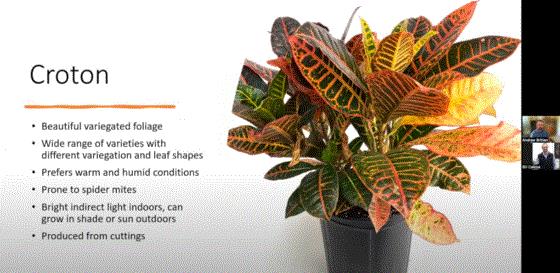
The challenge is always selection and knowing which crops you can reliably produce using your current structures and growing environments. If producing some tropical or foliage crops is on your to-do or to-explore list for 2026, why not make it a goal and get started? To help, I recorded conversations with Ball Seed’s tropical plant guru Andrew Britten about the best genera to consider … and you guessed it, we have this as a 3-part video and a podcast. Here are the links:
Talk to you next week!



Please feel free to send your comments, constructive criticism and topic ideas to me at bcalkins@ballhort.com.

Bill Calkins
Editor - Tech On Demand
This email was received by you and 25,527 other fine subscribers!
If you're interested in advertising in Tech On Demand, contact Kim Brown ASAP and she'll hook you up.